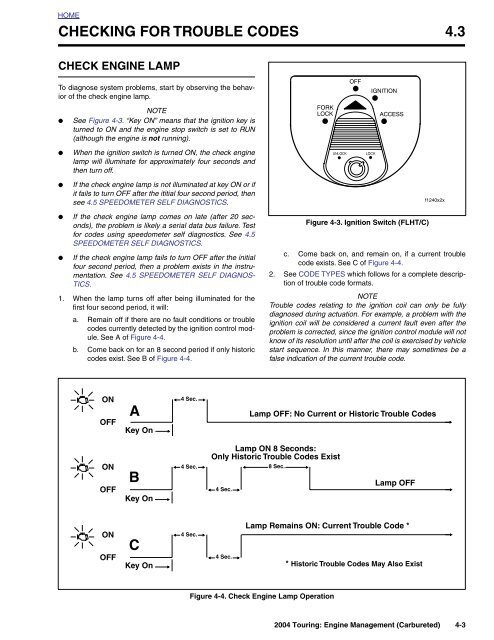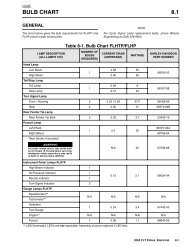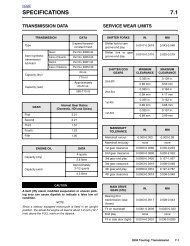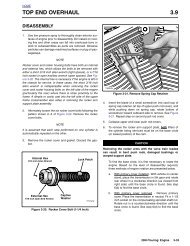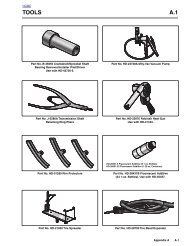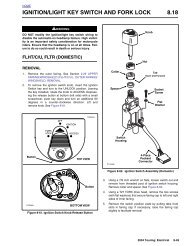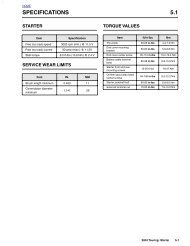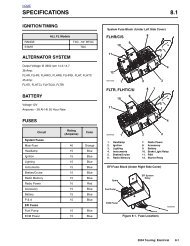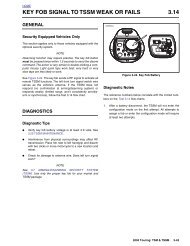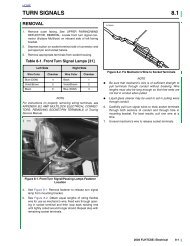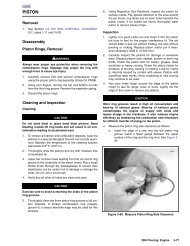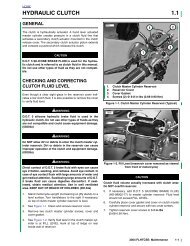4.4 initial diagnostic check: icm - harley-davidson-sweden.se
4.4 initial diagnostic check: icm - harley-davidson-sweden.se
4.4 initial diagnostic check: icm - harley-davidson-sweden.se
Create successful ePaper yourself
Turn your PDF publications into a flip-book with our unique Google optimized e-Paper software.
HOME<br />
CHECKING FOR TROUBLE CODES 4.3<br />
CHECK ENGINE LAMP<br />
To diagno<strong>se</strong> system problems, start by ob<strong>se</strong>rving the behavior<br />
of the <strong>check</strong> engine lamp.<br />
●<br />
●<br />
●<br />
●<br />
●<br />
NOTE<br />
See Figure 4-3. “Key ON” means that the ignition key is<br />
turned to ON and the engine stop switch is <strong>se</strong>t to RUN<br />
(although the engine is not running).<br />
When the ignition switch is turned ON, the <strong>check</strong> engine<br />
lamp will illuminate for approximately four <strong>se</strong>conds and<br />
then turn off.<br />
If the <strong>check</strong> engine lamp is not illuminated at key ON or if<br />
it fails to turn OFF after the ititial four <strong>se</strong>cond period, then<br />
<strong>se</strong>e 4.5 SPEEDOMETER SELF DIAGNOSTICS.<br />
If the <strong>check</strong> engine lamp comes on late (after 20 <strong>se</strong>conds),<br />
the problem is likely a <strong>se</strong>rial data bus failure. Test<br />
for codes using speedometer <strong>se</strong>lf <strong>diagnostic</strong>s. See 4.5<br />
SPEEDOMETER SELF DIAGNOSTICS.<br />
If the <strong>check</strong> engine lamp fails to turn OFF after the <strong>initial</strong><br />
four <strong>se</strong>cond period, then a problem exists in the instrumentation.<br />
See 4.5 SPEEDOMETER SELF DIAGNOS-<br />
TICS.<br />
1. When the lamp turns off after being illuminated for the<br />
first four <strong>se</strong>cond period, it will:<br />
a. Remain off if there are no fault conditions or trouble<br />
codes currently detected by the ignition control module.<br />
See A of Figure 4-4.<br />
b. Come back on for an 8 <strong>se</strong>cond period if only historic<br />
codes exist. See B of Figure 4-4.<br />
Figure 4-3. Ignition Switch (FLHT/C)<br />
f1240x2x<br />
c. Come back on, and remain on, if a current trouble<br />
code exists. See C of Figure 4-4.<br />
2. See CODE TYPES which follows for a complete description<br />
of trouble code formats.<br />
NOTE<br />
Trouble codes relating to the ignition coil can only be fully<br />
diagno<strong>se</strong>d during actuation. For example, a problem with the<br />
ignition coil will be considered a current fault even after the<br />
problem is corrected, since the ignition control module will not<br />
know of its resolution until after the coil is exerci<strong>se</strong>d by vehicle<br />
start <strong>se</strong>quence. In this manner, there may sometimes be a<br />
fal<strong>se</strong> indication of the current trouble code.<br />
ON<br />
OFF<br />
A<br />
Key On<br />
4 Sec.<br />
Lamp OFF: No Current or Historic Trouble Codes<br />
ON<br />
OFF<br />
B<br />
Key On<br />
4 Sec.<br />
Lamp ON 8 Seconds:<br />
Only Historic Trouble Codes Exist<br />
4 Sec.<br />
8 Sec.<br />
Lamp OFF<br />
ON<br />
OFF<br />
C<br />
Key On<br />
4 Sec.<br />
4 Sec.<br />
Lamp Remains ON: Current Trouble Code *<br />
* Historic Trouble Codes May Also Exist<br />
Figure 4-4. Check Engine Lamp Operation<br />
2004 Touring: Engine Management (Carbureted) 4-3


